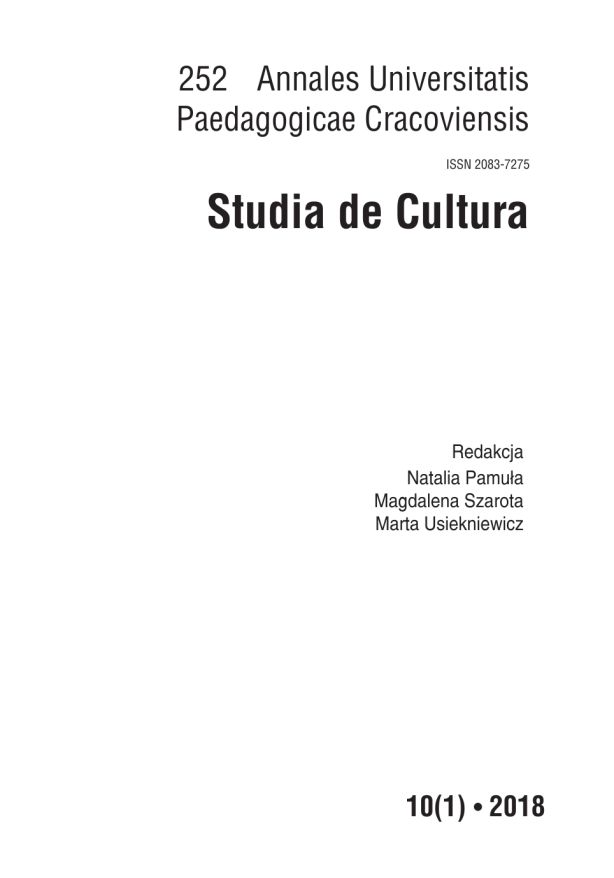Abstract
10.24917/20837275.10.1.8
Tekst jest próbą spojrzenia na historię dyskursu o autyzmie z perspektywy studiów o niepełnosprawności. Ze względu na nieostrą definicję i wciąż niepoznane przyczyny autyzm stanowił przestrzeń kulturowych projekcji na temat niepełnosprawności i choroby psychicznej. Jak argumentuję, zarówno determinacja współczesnej nauki, jak i jej porażka w obiektywizacji autyzmu za pomocą metod nauk empirycznych ma związek z odcieleśnioną naturą autyzmu, która wciąż ujawnia swoją arbitralność i społeczną, a nie biologiczną, konstrukcję. Jednocześnie dopiero w XXI wieku do głosu doszły same osoby autystyczne, które próbują uczynić z autyzmu pozytywny i integralny element swojej tożsamości.
Autism disembodied. The history of social construction of autism as illness, disorder, and disability
The article is an attempt to look at the history of discourse about autism from the perspective of autism studies. Due to the blurred definition and yet unknown etiology autism was used as a space for modern cultural projections about disability and mental illness. As I argue, both the determination of modern scientific institutions and their failure to objectify autism using empirical methods are linked to the disembodied nature of autism, which still reveals it arbitrariness and social - not natural - construction. As late as in 21th century, autistic people have joined the discourse about themselves, trying to make autism a positive and integral aspect of their identity.
References
Asperger H. 1944/1991. ‘Autistic psychopathy’ in childhood. U. Frith (przeł.). W Autism and Asperger syndrome. U. Frith (red.). New York. 37–92.
View in Google Scholar
Autism S. 2006. “Landmark Legislation Authorizing Nearly $1 Billion in Autism Funding Now Moves Back to the Senate for Prompt Action”. https://www.autismspeaks.org/about-us/press-releases/cure-autism-now-and-autism-speaks-applaud-approval-combating-autism-act-unit (dostęp: 28.04.2017).
View in Google Scholar
Autistic Genocide Clock. 2005. https://web.archive.org/web/20051218121135/http://www.ventura33.com/clock/ (dostęp: 28.04.2017).
View in Google Scholar
CDC. 2014. “Prevalence of autism spectrum disorder among children aged 8 years – autism and developmental disabilities monitoring network, 11 sites, United States, 2010”. Morbidity and Mortality Weekly Report. Surveillance Summaries nr 63(SS02). 1–21.
View in Google Scholar
Czech H. 2018. “Hans Asperger, National Socialism, and «race hygiene» in Nazi-era Vienna”. Molecular Autism nr 9(1). 1–43.
View in Google Scholar
Davidson J., Orsini M. 2013. Critical Autism studies: Notes on an emerging Field. W Worlds of Autism: Across the Spectrum of Neurological Difference. J. Davidson, M. Orsini (red.). Minneapolis. 1–28.
View in Google Scholar
Davis L.J. (red.). 2006. The disability studies reader. New York.
View in Google Scholar
Dawson M. 2004. “The misbehaviour of behaviourists: ethical challenges to the autism-ABA industry”. http://web. archive. org/web/20051205014407/www. sentex. net/nexus23/naa_aba. html (dostęp: 15.09.2017).
View in Google Scholar
Donvan J., Zucker C. 2016. In a Different Key: The Story of Autism. New York.
View in Google Scholar
IACC. 2017. “2013 IACC Autism Spectrum Disorder Research Portfolio Analysis Report. U.S. Department of Health and Human Services Interagency Autism Coordinating Committee”. https://iacc.hhs.gov/portfolio-analysis/2013/index.shtml (dostęp: 28.04.2017).
View in Google Scholar
Facts about ASD. 2016. “Center for Disease Control and Prevention”. http://www.cdc.gov/ncbddd/autism/facts.html (dostęp: 5.07.2016).
View in Google Scholar
Herera S. 2005. “Autism Research Focuses on Early Intervention”. http://www.nbcnews.com/id/7013251#.V1LN6vmLTIU (dostęp: 5.07.2016).
View in Google Scholar
Kanner L. 1943. “Autistic disturbances of affective contact”. Nervous Child nr 2. 217–250.
View in Google Scholar
Lovaas O.I. 1987. “Behavioral treatment and normal educational and intellectual functioning in young autistic children”. Journal of Consulting and Clinical Psychology nr 55(1). 3–9.
View in Google Scholar
McGuire A. 2011. “Representing autism: A sociological examination of autism advocacy”. Atlantis: Critical Studies in Gender, Culture & Social Justice nr 35(2). 62–71.
View in Google Scholar
McGuire A. 2016. War on autism: On the cultural logic of normative violence. University of Michigan Press.
View in Google Scholar
McGuire A.E., Michalko R. 2011. “Minds between us: Autism, mindblindness and the uncertainty of communication”. Educational Philosophy and Theory nr 43(2). 162–177.
View in Google Scholar
Rekers G.A., Lovaas O.I. 1974. “Behavioral treatment of deviant sex-role behaviors in a male child”. Journal of Applied Behavior Analysis nr 7(2). 173–190.
View in Google Scholar
Silberman S. 2015. Neurotribes: The legacy of autism and the future of neurodiversity. London.
View in Google Scholar
Sinclair J. 1993. “Don’t Mourn For Us”. Our Voice: The Newsletter of Autism Network International nr 1(3). 1–4.
View in Google Scholar
Yergeau M. 2017. Authoring Autism: On Rhetoric and Neurological Queerness. Duke University Press.
View in Google Scholar
Weaver M. 2015. “Largest UK sperm bank turns away dyslexic donors”. The Guardian. https://www.theguardian.com/society/2015/dec/29/largest-uk-sperm-bank-turns-away-dyslexic-donors (dostęp: 26.10.2017).
View in Google Scholar
Williams D. 1992. Nobody nowhere: The extraordinary autobiography of an autistic girl. New York.
View in Google Scholar
World Health Organization 1992. The ICD-10 classification of mental and behavioural disorders: clinical descriptions and diagnostic guidelines. Vol. 1. World Health Organization.
View in Google Scholar

